From the Library of Leng
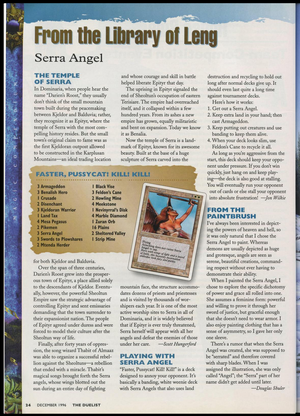
From the Library of Leng was a column in The Duelist magazine that ran from Issue 8 in December 1995 to Issue 15 in February 1997. It then moved to the Duelist Online website where it had at least three more columns.
Library columns generally had three main sections. Firstly, they provided a short story or some background about the character they featured. A second section gave a sample decklist built around the character's card. Then finally there was a section where the artist who illustrated the card gave insight about how they approached the brief they'd been given.
Eron the Relentless
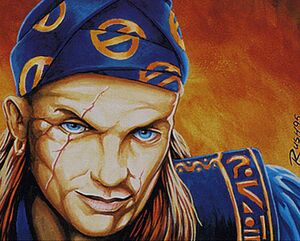
Eron the Relentless was featured in Issue 8[1] of The Duelist from December 1995.
The Man Who Would Be King
The column gives the background about how the Human thief Eron gained immortality after stealing a magical tome from Castle Sengir for the wizard Bernatheen, then rose to become the King of Ulgrotha's Goblins.
| “ | He forced his way into the palace hall and declared himself King of the Goblins. Of course, the Goblins killed him and threw him in the corner for the wolves to eat. When Eron got up a few minutes later, the Goblins killed him again, thinking him to be some terrible undead sent by Baron Sengir. When he got up again, Eron proclaimed his destiny to rule over the Goblin families. The Goblins decided to accept him and took the opportunity to rid themselves of the current ruling family.[1] | ” |
Playing with Eron
Unlike following columns, there was no sample decklist given for Eron. Instead it was suggested that First Strike and Trample would be good abilities to give him, and the cards Bloodlust and Stone Giant could work quite well.
Eron: an Artist's View
Eron was illustrated by Christopher Rush.
| “ | "Portraying a character's personality in a painting is one of my favorite challenges, and this self-appointed king offered a lot to work with. The description I was given was very simple: 'Eron is regal, crazy-eyed, and damn good-looking. It would be good to show a few of his scars.' [1] | ” |
Autumn Willow
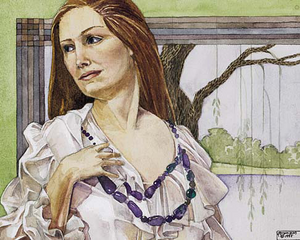
Autumn Willow was featured in Issue 9[2], in February 1996.
Caretaker of the Wood
The story describes how Autumn Willow, originally a simple forest spirit, gained sentience after the planeswalker Feroz isolated the plane of Ulgrotha from the rest of the Multiverse. And then, with the failure of Feroz's Ban, she finds her powers slipping while she tries to save the folk of An-Havva from the Baron Sengir.
| “ | On the evening that Feroz died, Autumn Willow had a vision of Baron Sengir marching the survivors of a terrible war into another world. The sending rang so loudly of prophecy that she had to act upon it. She redoubled her efforts to keep the vampires and undead from traversing through her Wood and worked harder at maintaining her defenses.[2] | ” |
Artist's Perspective
Autumn Willow was illustrated by Margaret Organ-Kean. Fellow Magic artist Kaja Foglio modeled for the reference photographs.
| “ | At first I imagined Autumn Willow as a woman in regal robes. After I read the Homelands background, however, I found the story of her waning power a sad one and decided that a softer, romantic portrayal would be more appropriate. I also chose to paint her as a human figure due to my background in classical and Renaissance art history, periods in which dryads and forest goddesses were depicted as women.[2] | ” |
Playing with Autumn Willow
The sample deck for Autumn Willow is a green and white control deck which aims to blank the opponent's removal by only playing untargetable creatures. It was designed by Melody Alder.
| “ | Your main concern is to keep in mind Autumn Willow’s strengths and keep from inadvertently countering them. For example, while Fyndhorn or Llanowar Elves seem like good additions to the deck – they provide fast mana for getting out your expensive creatures – your opponent will probably have a hand full of anti-creature cards that she hasn’t been able to use on Autumn Willow and Blinking Spirit. This deck capitalises on your opponent’s having dead cards in her hand, and if she can’t use her Terror’s on Autumn Willow, she will most certainly use it on Elves.[2] | ” |
Artifacts (7)
Baron Sengir
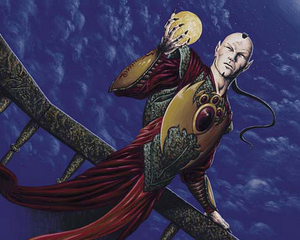
Baron Sengir was featured in Issue 10[3] from May 1996.
Immortal Gentleman and Politician
The column's story was written by Scott Hungerford. It is an implied in-universe biography which provides a sanitised account of Baron Sengir. His positive attributes are talked up, while actions that would otherwise be seen as cruel or evil are dismissed as unimportant or simple pragmatism.
| “ | Baron Sengir is misunderstood by most people of the Homelands. Quite unlike the ravenous hordes of flying, devious Sengir Vampires, the Baron is the very model of a modern Dominarian gentleman. This local hunter of the night has class. The Baron would rather have you to dinner and entwine you in political theory than go for your throat. Strolling the battlements of Castle Sengir discussing philosophy and dwarven engineering is far more important to him than terrorizing the countryside and kidnapping villagers for fiendish plots.[3] | ” |
Playing with Baron Sengir
The sample deck for Baron Sengir is monoblack with typal Vampire and regeneration themes. It was designed by Jon Wilkie.
| “ | There are several decent combos in this deck, each designed to give your opponent the heebie-jeebies. Krovikan Vampire + Baron Sengir creature control, while the same combo with Sengir Vampire makes for a fast-growing Vampire. Use your Terrors against any dangerous non-black, non-artifact creatures, and use Unholy Strength or Feast of the Unicorn to give your small creatures enough clout to attack with confidence. Finally, Soul Exchange used with Armor Thrull brings a dead creature straight into play, bigger than before.[3] | ” |
Creatures (21)
Sorceries (2)
Artist's Perspective
Baron Sengir was illustrated by Pete Venters. He describes his admiration for the art Anson Maddocks had done for Sengir Vampire and how he had specifically requested the assignment to paint the Baron when he visited the Wizards of the Coast offices during the design of Homelands.
| “ | From the start, I knew the Baron's portrait had to be a departure from the gothic look that has predominated in the depiction of vampires. I envisioned Baron Sengir as a general in control of his vampiric army, and from this came the idea of his wearing a breastplate. You probably won't be surprised to discover that the breastplate's ornamentation resembles a stylized bat. I based the Baron's features upon Anson's original vampire, adjusting it to make it less feral and to give the face a sense of nobility (the good looks were a bonus).[3] | ” |
Lord of Tresserhorn
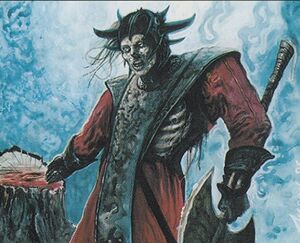
Lord of Tresserhorn was featured in Issue 11[4] from September 1996.
A Forced Ally
The column's story was written by Scott Hungerford. It describes a typical night for Lord of Tresserhorn, Regent for the Necromancer Lim-Dûl.
| “ | Shortly before sunrise, never sleeping, the Lord of Tresserhorn finishes his tale and rises from his great throne. Alone, he walks through the halls of Tresserhorn as if they were his own rather than his absent master's. Occasionally, when struck by melancholy, he quietly sings Kjeldoran battle hymns from the past or fingers the fine tapestries, now moldered and faded from decades of hanging across dirt-grimed window-panes.[4] | ” |
Playing with Lord of Tresserhorn
The sample deck for Lord of Treserhorn is and was designed by Jon Wilkie.
| “ | Lord of Tresserhorn is a little like Marlon Brando: impressive, but sometimes unwieldy. When the card comes into play, you have to pay 2 life and sacrifice two creatures, and a target opponent draws two cards. The deck below, affectionately called “Apocalypse Now,” utilises the card’s strong points.
Burn your opponents’ land with Hack and Flashfires and waste their creatures with Withering Wisps. After Withering Wisps has damaged your own Spiny Starfish (from Alliances) a few times you should have enough 0/1 Starfish tokens to sacrifice to Lord of Tresserhorn when it comes into play. The Lord is hard to get out, but once you do get it out, it’ll quickly take out any remaining blockers. Sol’kanar can also help out, and a single Hack can make it unblockable. The deck even has a light spicing of direct damage and countering ability![4] |
” |
Enchantments (3)
Artist's Perspective
Lord of Tresserhorn was illustrated by Anson Maddocks.
| “ | Lord of Tresserhorn is a powerful minion of Lim-Dûl; thus, I wanted to create an atmosphere thick with doom and despair. One technique for doing so is to obscure conventional elements that allow you to read someone's personality and intentions. Light wraps around Lord of Tresserhorn from the side, giving him form, but there's less detail in his face, making him look more serious and ominous. He's not in comic-book perspective - he's not in-your-face threatening. Rather, I tried to paint him to appear content with the fact that you're going to be next on his chopping block.[4] | ” |
Verduran Enchantress
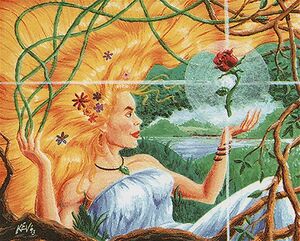
Verduran Enchantress was featured in Issue 12[5] from September 1996.
She Walks With Gentle Grace
The column's story was written by Scott Hungerford. It offers a brief overview of the idyllic island of Verdura and its almost-exclusively female inhabitants' adherence to a powerful unnamed Avatar.
| “ | Most of the women who live here have devoted their lives to the avatar of Verdura, a decidedly female entity of great power and age whose true name is known only to those sworn to the Verduran Order. Those who walk with gentle grace upon Verdura's soil are welcome, but males and those who seek violence or plunder inevitably meet great resistance from the owners of the island, competent spellcasters all.[5] | ” |
An Enchanting Deck
The sample deck is, naturally, an Enchantress deck. This archetype, which plays a lot of enchantments to draw lots of extra cards, was named after Verduran Enchantress.
| “ | This deck, called "The Big Combo," develops slowly, building to a frenzied pace of enchantments and creatures. The key to the deck's speed comes from having Verduran Enchantress and Sylvan Library in play. Later on, you can increase the power and toughness of your creatures with Aspect of Wolf and continue to pummel away. The deck also has several nice card combinations: Gorilla Berserkers and Lure; Whip Vine and Regeneration; Yavimaya Ancients and Carapace or Web; Lure, Venom, and any creature; and Rabid Wombat and a zillion enchantments.[5] | ” |
From The Paintbrush
Verduran Enchantress was illustrated by Kev Brockschmidt.
| “ | I wanted to do something different from anything I had seen before - not an enchantress merely throwing spells at nature, but rather one becoming a part of nature. She is in control of everything within the picture, her hair and body forming the frame and encompassing the forest beyond, her hand manipulating the rose. At the same time, she is also entwined by her environment, her hair windblown and sprouting flowers, her fingers becoming the vines of the rose, which is the center of her attention. Has she been picking flowers magically, drawing some sort of energy from them, or is she in the process of creating?[5] | ” |
Phyrexian Dreadnought and Prismatic Circle

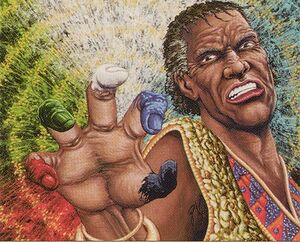
Phyrexian Dreadnought and Prismatic Circle both featured in Issue 13[6] from October 1996.
Lost History
The column's main story was written by Scott Hungerford and Jon Wilkie details the finding of a sea chest containing a journal telling the story of a Pirate Ship becoming stranded on a distant island occupied by Clockwork Gnomes.
| “ | But their good fortune ended when they encountered a gigantic castle on an island barren of life, all this made even more intimidating by the whirling æther storm surrounding the castle’s tallest spire. The captain of the Wavecrester, so much in awe of this phenomenon, cast a portent spell and recoiled in shock at what she saw within the structure: emotionless, mechanical clockwork gnomes building legions of flying servants. All of the creatures, gnomes, clockwork avians, and mechanical wasps alike, were constructing a massive dreadnought of metal and sorcery, a destructive artifact the likes of which present-day Dominaria had never seen.[6] | ” |
An insert, "The War of Mirage", gives an overview of the wider Mirage block storyline and was written by Hungerford and Pete Venters.
Playing Competing Decks
THE WAVECRESTER
The first sample deck is and is built around Prismatic Circle.
| “ | The victory is yours if you can use your Pirate Ship to deal the finishing blow to your opponent’s life total. The Wavecrester has defeated the gnomes, learned the secrets of Steel Island, and escaped alive![6] | ” |
- Note
Prismatic Circle is written "Prismatic CoP" on the printed decklist, and Circle of Protection: Red is written "CoP: Red".
STEEL ISLAND
The second sample deck is and is built around Phyrexian Dreadnought
| “ | Cast Phyrexian Dreadnought; then enchant it with Soar from Mirage (“target creature gains flying and +0/+1”) to win. The clockwork gnomes board the dreadnought and fly off across the ocean in search of their creator.[6] | ” |
Creatures (12)
From The Paintbrush
Both cards were illustrated by Pete Venters.
| “ | The fiends found in Phyrexia have a twisted, inhuman aesthetic, reminiscent of the biomechanical work of H. R. Giger, but with rusty cogs, gears, and pistons to give them a bit of the steam-punk look. That’s why the creature is such a misshapen mass of parts. Actually I had drawn the Dreadnought the other way up for much of its creation, and it was only when I felt I wanted it to curve back on itself that I decided on the composition you see now. I added the planeswalker Taysir in the lower right-hand corner to give the beast scale. He’s just about to make the wise decision to get the hell outta there!
With Prismatic Circle of Protection, I wanted to transfer an image of the Magic color pentagram onto a mage. When I realized that the logical place was the hand, it was pretty much smooth sailing. I locked one of my hands into a claw. Several drawings and one fierce hand cramp later, I had what I needed.[5] |
” |
Serra Angel

Serra Angel was featured in Issue 14[7] from December 1996.
The Temple of Serra
The column's story was written by Scott Hungerford. It gives a history of the shrine to the Angel planeswalker Serra at Epityr.
| “ | In Dominaria, when people hear the name “Darien’s Roost,” they usually don’t think of the small mountain town built during the peacemaking between Kjeldor and Balduvia; rather, they recognize it as Epityr, where the temple of Serra with the most compelling history resides. But the small town’s original claim to fame was as the first Kjeldoran outpost allowed to be constructed in the Karplusan Mountains, an ideal trading location for both Kjeldor and Balduvia.[7] | ” |
Playing With Serra Angel
The sample deck for Serra Angel is monowhite with Banding creatures and powerful artifacts.
| “ | “Faster, Pussycat! Kill! Kill!” is a deck designed to annoy your opponent. It’s basically a banding, white weenie deck with Serra Angels that also uses land destruction and recycling to hold out long after normal decks give up. It should even last quite a long time against tournament decks.[7] | ” |
From The Paintbrush
Serra Angel was illustrated by Douglas Shuler.
| “ | When I painted the Serra Angel, I chose to explore the specific dichotomy of power and grace all rolled into one. She assumes a feminine form: powerful and willing to prove it through her sword of justice, but graceful enough that she doesn’t need to wear armor. I also enjoy painting clothing that has a sense of asymmetry, so I gave her only one sleeve.[7] | ” |
Goblin Recruiter
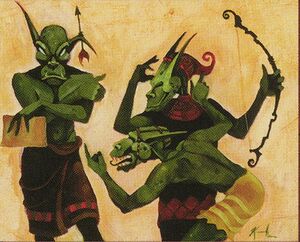
Goblin Recruiter was featured in Issue 15[8] from February 1997. It was the final Library of Leng column physically printed in The Duelist.
Visions’ Goblin Recruiter
The column's story was written by Scott "Scooter" Hungerford. It takes the form of a field-guide to different types of Goblins.
| “ | Among Argivian scholars, it’s a documented fact that the further one gets from the site of the Brothers’ War (on the shattered continent of Terisiare), the more feral, beast-like, and generally stupid the local goblins tend to become. One of the most notorious tribes is the Rundvelt goblins, who have mastered the use of Rock Sleds, siege equipment, and even developed an effective societal structure. In Jamuraa, however, the goblins are generally no better than stick-wielding idiots.[8] | ” |
Playing With Goblin Recruiter
The sample deck for Goblin Recruiter has a red typal Goblin theme.
| “ | The deck you see here, called “Good-bye, Children” can be played as a normal weenie deck until you draw Goblin Recruiter. Then use the Recruiter to stack five or six Goblins on your library. One of those should, of course, be another Recruiter. Play all but the Recruiter, which you hold your hand, and when you need another dose of creatures, cast the second Recruiter. Rinse and repeat.[8] | ” |
Creatures (24)
Instants (2)
From The Paintbrush
Goblin Recruiter was illustrated by Scott Kirschner.
| “ | The challenge would be to depict a comedic occurrence — something quite new to me. After all, most of the time my work deals with more serious images. So when I sat down to start my sketches, I first concentrated on what situation I could put the goblins in. I figured the nature of goblins’ humor would probably be somewhat sadistic. Obviously, as you can see from the card, the end result of my brainstorming was a goblin accidentally discharging an arrow that pierced the ear of the Recruiter. One goblin can’t contain his laughter, while the other one tries very hard not to laugh.[8] | ” |
Suq'Ata Assassin

Suq'Ata Assassin was the focus of the first Library of Leng column on The Duelist Online[9]. Unlike previous columns, there wasn't a section from the artist, Gary Gianni.
The Assassins of Suq'Ata
The story section was written by Scott Hungerford. It gave background on the Suq’Ata, their origins on the plane of Rabiah the Infinite, and their current organisation in Jamuraa.
| “ | Within the modern cities of the Suq’Ata there exists a network of secret guilds wholly devoted to murder. Using spells of summoning, fear, and mind-numbing cold, the assassins of Suq’Ata seek not to defeat their opponents outright, but to poison them over time in a variety of insidious ways–perhaps a cobra trained to remain still until it strikes, or food tainted with a tasteless poison, delivered by an unseen hand.[9] | ” |
The Young Poisoner's Handbook
The sample deck for Suq'Ata Assassin was black and green with a Poison theme. It was designed by Jon Wilkie.
| “ | The key to "The Young Poisoner's Handbook" is to play fast and mean. If you get a creature through unblocked ten times, the game is over. Use Terror to shut down creatures early in the game, saving Winter Blast to slip poison creatures through late in the game. Above all else, attack all the time! The game will be decided quickly one way or another, and only by playing aggressively will you be victorious.[9] | ” |
Lost columns
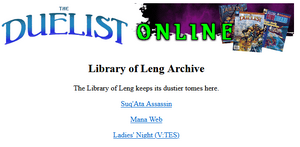
There are three decks linked on an archived version of The Duelist Online's Library of Leng Archive page. These are:
- Suq'Ata Assassin
- Mana Web
- Ladies' Night (VTES)
Only the Suq'Ata Assassin page is still retrievable, and did feature a short teaser about the upcoming Vampire: The Eternal Struggle column:
| “ | That's about it for this month. Next month we'll be featuring our first non-Magic deck in Library of Leng, and we think you'll like it a lot. It's called "Ride of the Valkyries," and it's an all-female deck for Vampire: The Eternal Struggle. See you here next month![9] | ” |
References
- ↑ a b c From the Library of Leng: Eron the Relentless (pdf). The Duelist, p. 59. Wizards of the Coast (December 1995). Archived from the original on August 15, 2022.
- ↑ a b c d From the Library of Leng: Autumn Willow (pdf). The Duelist, p. 68. Wizards of the Coast (February 1996). Archived from the original on March 26, 2020.
- ↑ a b c d From the Library of Leng: Baron Sengir (pdf). The Duelist, p. 59. Wizards of the Coast (May 1996). Archived from the original on October 20, 2022.
- ↑ a b c d From the Library of Leng: Lord of Tresserhorn (pdf). The Duelist, p. 59. Wizards of the Coast (September 1996). Archived from the original on August 15, 2022.
- ↑ a b c d e From the Library of Leng: Verduran Enchantress (pdf). The Duelist, p. 59. Wizards of the Coast (September 1996). Archived from the original on October 27, 2020.
- ↑ a b c d [hhttps://archive.org/details/the-duelist-13/page/n25/mode/2up From the Library of Leng: Phyrexian Dreadnought and Prismatic Circle] (pdf). The Duelist, p. 24. Wizards of the Coast (October 1996). Archived from the original on March 8, 2023.
- ↑ a b c d From the Library of Leng: Serra Angel (pdf). The Duelist, p. 24. Wizards of the Coast (December 1996). Archived from the original on February 22, 2023.
- ↑ a b c d From the Library of Leng: Goblin Recruiter (pdf). The Duelist, p. 36. Wizards of the Coast (February 1997). Archived from the original on October 30, 2020.
- ↑ a b c d Jon Wilkie and Scott Hungerford (1997). "The Young Poisoner's Handbook (website)". Wizards of the Coast. Archived from the original on June 06, 1997.